Long-Term Stable Online Acetylene Detection by a CEAS System with Suppression of Cavity Length Drift
Abstract
:1. Introduction
2. Absorption Line Selection
3. System Structure and Design of Key Modules
3.1. Structure and Configuration
3.2. Tuning Characteristics of the Laser
3.3. Optical ModuleDdesign
3.4. Electro-Optic Modulation-Based PDH Locking Scheme
3.5. Cavity Length Feedback Locking
4. Experiment and Results
4.1. C2H2 Absorbance Measurements
4.2. Calibration and Stability
5. Comparison and Conclusion
Author Contributions
Funding
Conflicts of Interest
References
- Utsav, K.C.; Nasir, E.F.; Farooq, A. A mid-infrared absorption diagnostic for acetylene detection. Appl. Phys. B 2015, 120, 223–232. [Google Scholar]
- Cao, Y.; Jin, W.; Ho, H.L.; Qi, L.; Yang, Y.H. Acetylene detection based on diode laser QEPAS: Combined wavelength and residual amplitude modulation. Appl. Phys. B 2012, 109, 359–366. [Google Scholar] [CrossRef]
- He, Q.X.; Zheng, C.T.; Liu, H.F.; Bin Li, B.; Wang, Y.D.; Tittel, F.K. Performance improvement of a near-infrared acetylene sensor system by reducing residual amplitude modulation. Laser Phys. 2017, 27, 055702. [Google Scholar] [CrossRef]
- Ghoneim, S.S.M.; Taha, I.B.M. A new approach of DGA interpretation technique for transformer fault diagnosis. Int. J. Electr. Power 2016, 81, 265–274. [Google Scholar] [CrossRef]
- Wu, Z.Y.; Gong, Y.H.; Yu, Q.X. Photoacoustic spectroscopy detection and extraction of discharge feature gases in transformer oil based on 1.5 mu tunable fiber laser. Infrared Phys. Technol. 2013, 58, 86–90. [Google Scholar] [CrossRef]
- Banik, G.D.; Som, S.; Maity, A.; Pal, M.; Maithani, S.; Mandal, S.; Pradhan, M. An EC-QCL based N2O sensor at 5.2 mu m using cavity ring-down spectroscopy for environmental applications. Anal. Methods-UK 2017, 9, 2315–2320. [Google Scholar] [CrossRef]
- Zhou, S.; Han, Y.L.; Li, B.C. Pressure optimization of an EC-QCL based cavity ring-down spectroscopy instrument for exhaled NO detection. Appl. Phys. B. 2018, 124, 27. [Google Scholar] [CrossRef]
- Maity, A.; Pal, M.; Banik, G.D.; Maithani, S.; Pradhan, M. Cavity ring-down spectroscopy using an EC-QCL operating at 7.5 mu m for direct monitoring of methane isotopes in air. Laser Phys. Lett. 2017, 14, 115701. [Google Scholar] [CrossRef]
- Markus, C.R.; Perry, A.J.; Hodges, J.N.; McCall, B.J. Improving cavity-enhanced spectroscopy of molecular ions in the mid-infrared with up-conversion detection and Brewster-plate spoilers. Opt. Express 2017, 25, 3709–3721. [Google Scholar] [CrossRef]
- Baran, S.G.; Hancock, G.; Peverall, R.; Ritchie, G.A.D.; van Leeuwen, N.J. Optical feedback cavity enhanced absorption spectroscopy with diode lasers. Analyst 2009, 134, 243–249. [Google Scholar] [CrossRef]
- Okeefe, A.; Deacon, D.A.G. Cavity Ring-down Optical Spectrometer for Absorption-Measurements Using Pulsed Laser Sources. Rev. Sci. Instrum. 1988, 59, 2544–2551. [Google Scholar] [CrossRef]
- Nadeem, F.; Postma, B.R.; Postma, G.; Cristescu, S.M.; Mandon, J.; Harren, F.J.M. Comprehensive three-dimensional ray tracing model for three-mirror cavity-enhanced spectroscopy. Appl. Opt. 2018, 57, 154–163. [Google Scholar] [CrossRef] [PubMed]
- Kasyutich, V.L.; Canosa-Mas, C.E.; Pfrang, C.; Vaughan, S.; Wayne, R.P. Off-axis continuous-wave cavity-enhanced absorption spectroscopy of narrow-band and broadband absorbers using red diode lasers. Appl. Phys. B 2002, 75, 755–761. [Google Scholar] [CrossRef]
- Tan, Z.Q.; Long, X.W.; Feng, X.W.; Wei, Z.M. The study of wavelength modulation off-axis integrated cavity output spectroscopy in the case of Lorentzian absorption profile. Opt. Commun. 2011, 284, 852–856. [Google Scholar] [CrossRef]
- Miller, J.H.; Bakhirkin, Y.A.; Ajtai, T.; Tittel, F.K.; Hill, C.J.; Yang, R.Q. Detection of formaldehyde using off-axis integrated cavity output spectroscopy with an interband cascade laser. Appl. Phys. B. 2006, 85, 391–396. [Google Scholar] [CrossRef]
- Centeno, R.; Mandon, J.; Cristescu, S.M.; Harren, F.J.M. Sensitivity enhancement in off-axis integrated cavity output spectroscopy. Opt. Express 2014, 22, 27985–27991. [Google Scholar] [CrossRef]
- Morville, J.; Kassi, S.; Chenevier, M.; Romanini, D. Fast, low-noise, mode-by-mode, cavity-enhanced absorption spectroscopy by diode-laser self-locking. Appl. Phys. B. 2005, 80, 1027–1038. [Google Scholar] [CrossRef]
- Gherman, T.; Romanini, D. Mode–locked cavity–enhanced absorption spectroscopy. Opt. Express 2002, 10, 1033–1042. [Google Scholar] [CrossRef]
- Thorpe, M.J.; Clausen, D.B.; Kirchner, M.S.; Ye, J. Cavity-enhanced optical frequency comb spectroscopy: Application to human breath analysis. Opt. Express 2008, 16, 2387–2397. [Google Scholar] [CrossRef]
- Alrahman, C.A.; Khodabakhsh, A.; Schmidt, F.M.; Qu, Z.; Foltynowicz, A. Cavity-enhanced optical frequency comb spectroscopy of high-temperature H2O in a flame. Opt. Express 2014, 22, 13889–13895. [Google Scholar] [CrossRef]
- Su, J.; Jiao, M.X.; Jiang, F. Pound-Drever-Hall laser frequency locking technique based on orthogonal demodulation. Optik 2018, 168, 348–354. [Google Scholar]
- Rothman, L.S.; Gordon, I.E.; Babikov, Y.; Barbe, A.; Benner, D.C.; Bernath, P.F.; Birk, M.; Bizzocchi, L.; Boudon, V.; Brown, L.R.; et al. The HITRAN2012 molecular spectroscopic database. J. Quant Spectrosc. Radiat. 2013, 130, 4–50. [Google Scholar] [CrossRef] [Green Version]
- Kogelnik, H.; Li, T. Laser Beams and Resonators. Appl. Opt. 1966, 5, 1550–1567. [Google Scholar] [CrossRef] [PubMed]
- Hagel, G.; Houssin, M.; Knoop, M.; Champenois, C.; Vedel, M.; Vedel, F. Long-term stabilization of the length of an optical reference cavity. Rev. Sci. Instrum. 2005, 76, 123101. [Google Scholar] [CrossRef] [Green Version]
- Mu, Y.; Hu, T.L.; Gong, H.; Ni, R.W.; Li, S.J. A Trace C2H2 Sensor Based on an Absorption Spectrum Technique Using a Mid-Infrared Interband Cascade Laser. Micromachines 2018, 9, 530. [Google Scholar] [CrossRef] [PubMed]
- Ma, G.M.; Zhao, S.J.; Jiang, J.; Song, H.T.; Li, C.R.; Luo, Y.T.; Wu, H. Tracing Acetylene Dissolved in Transformer Oil by Tunable Diode Laser Absorption Spectrum. Sci. Rep. 2017, 7, 14961. [Google Scholar] [CrossRef] [PubMed] [Green Version]
- Zheng, K.Y.; Zheng, C.T.; He, Q.X.; Yao, D.; Hu, L.; Zhang, Y.; Wang, Y.D.; Tittel, F.K. Near-infrared acetylene sensor system using off-axis integrated-cavity output spectroscopy and two measurement schemes. Opt. Express 2018, 26, 26205–26216. [Google Scholar] [CrossRef]
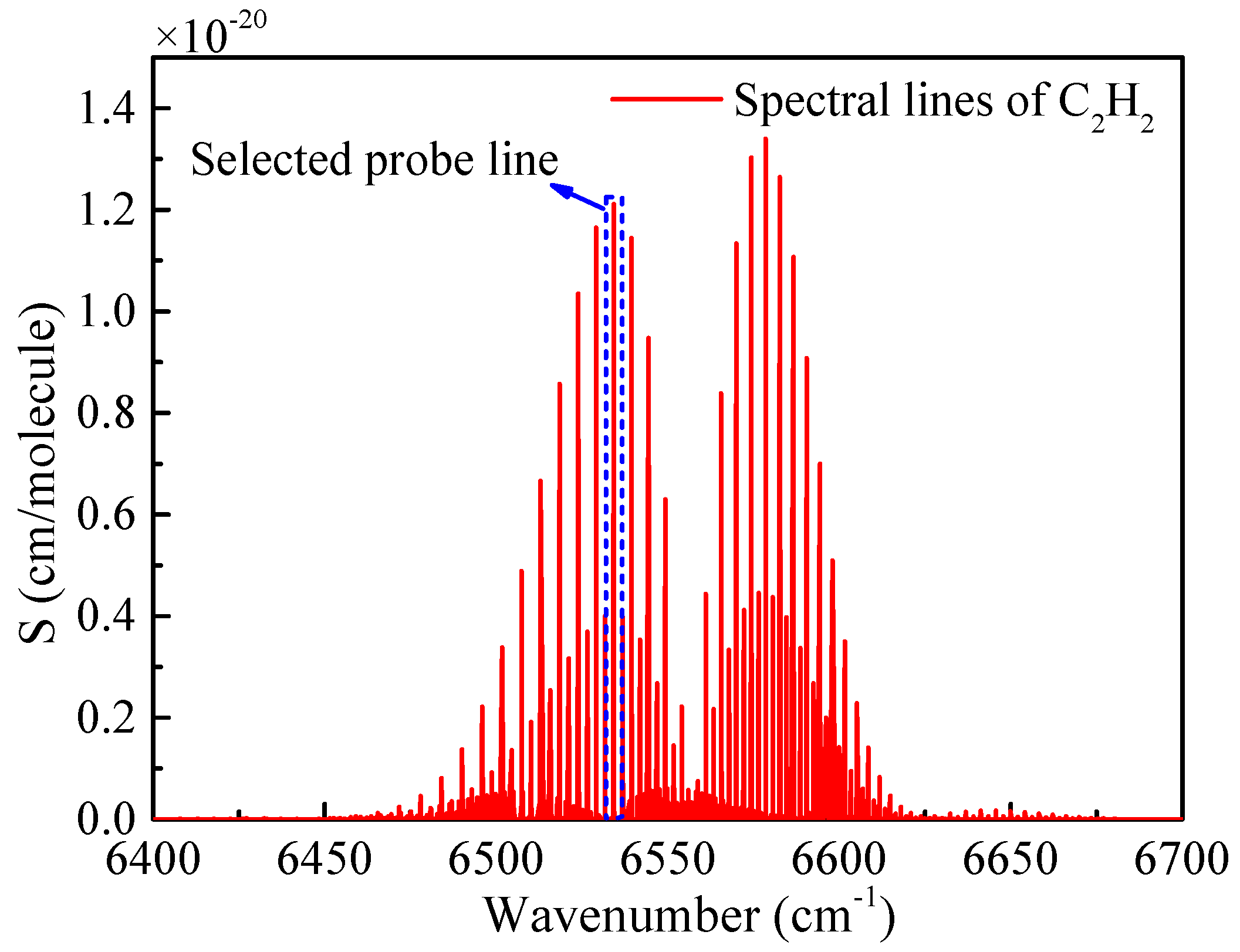


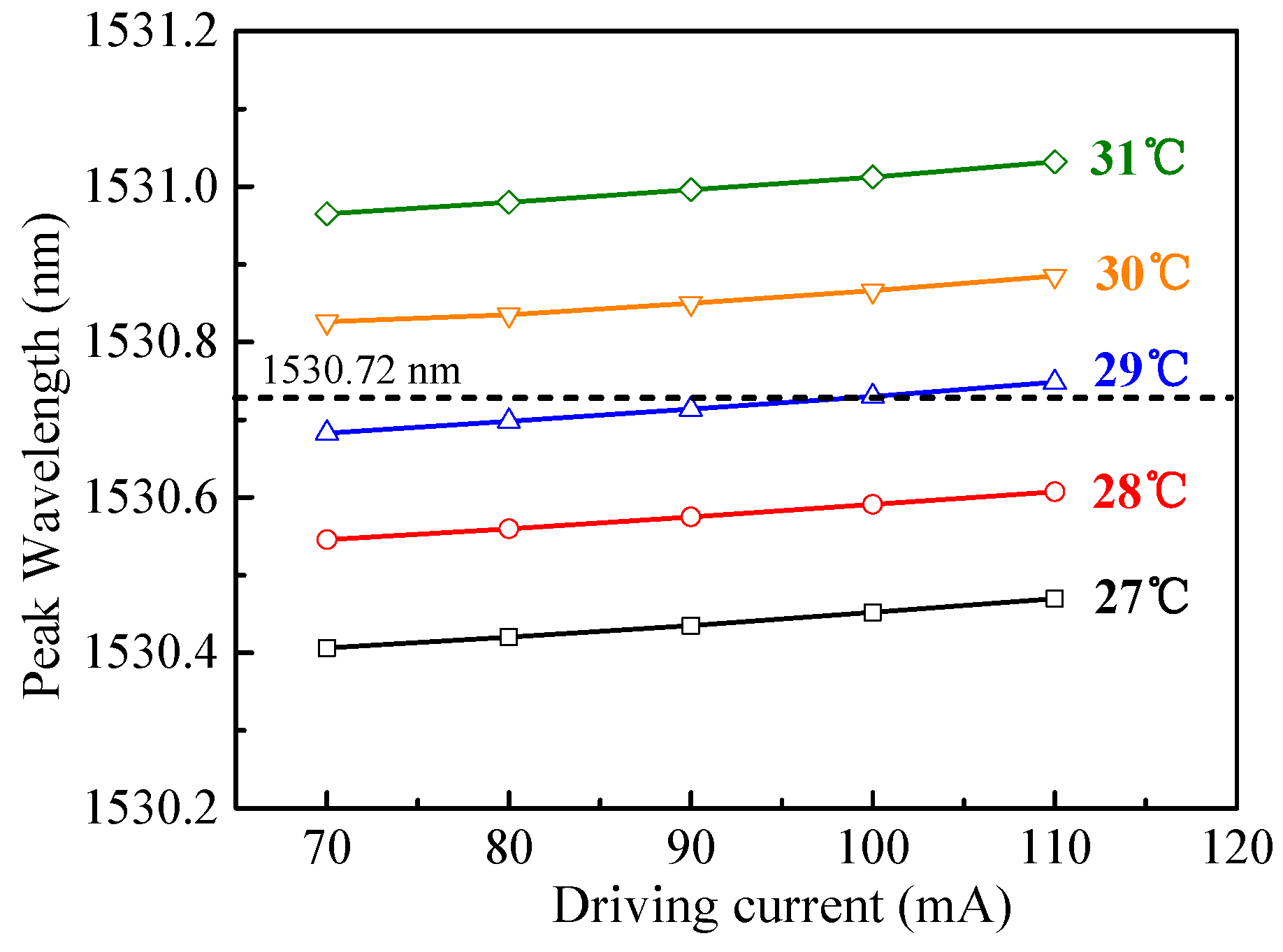
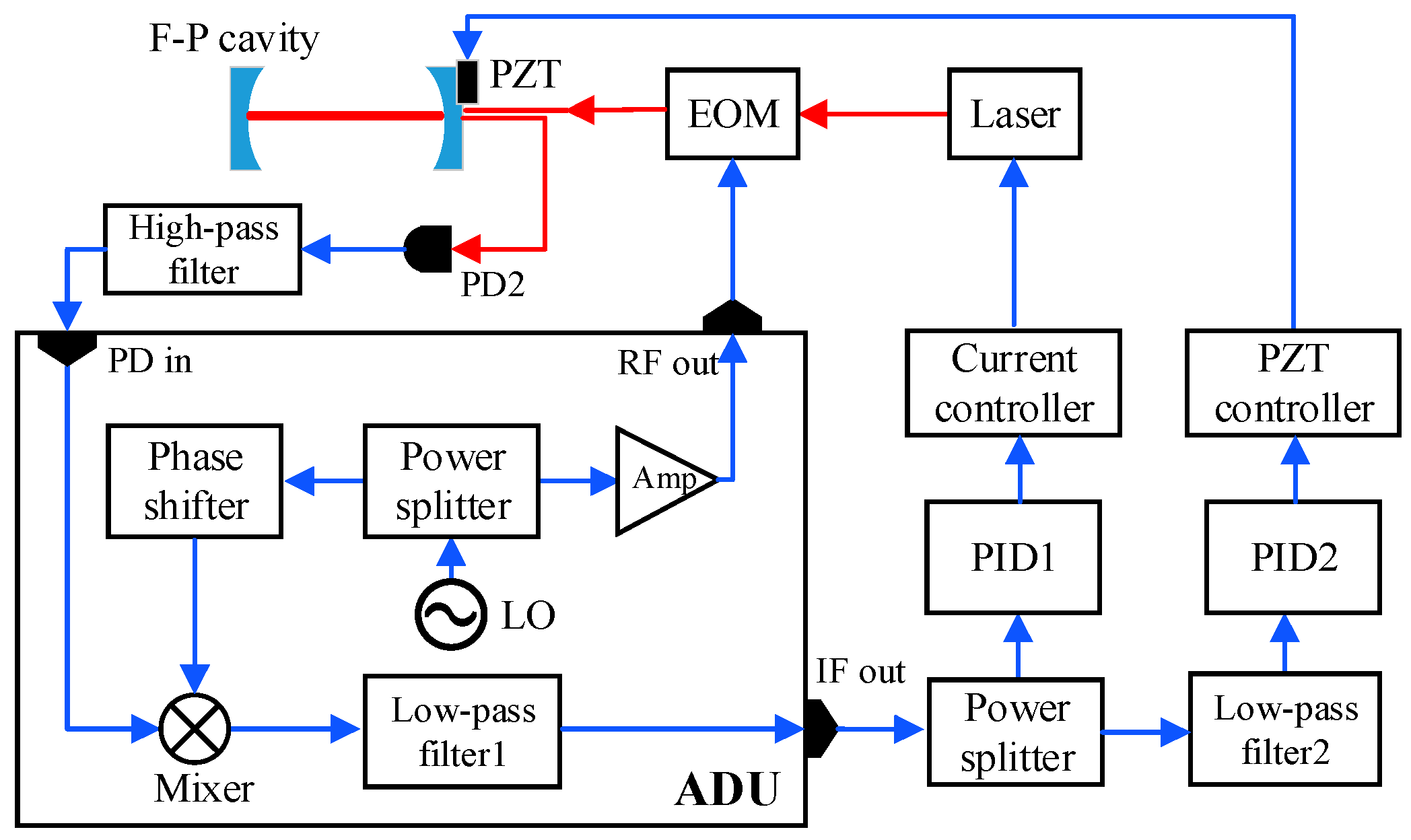
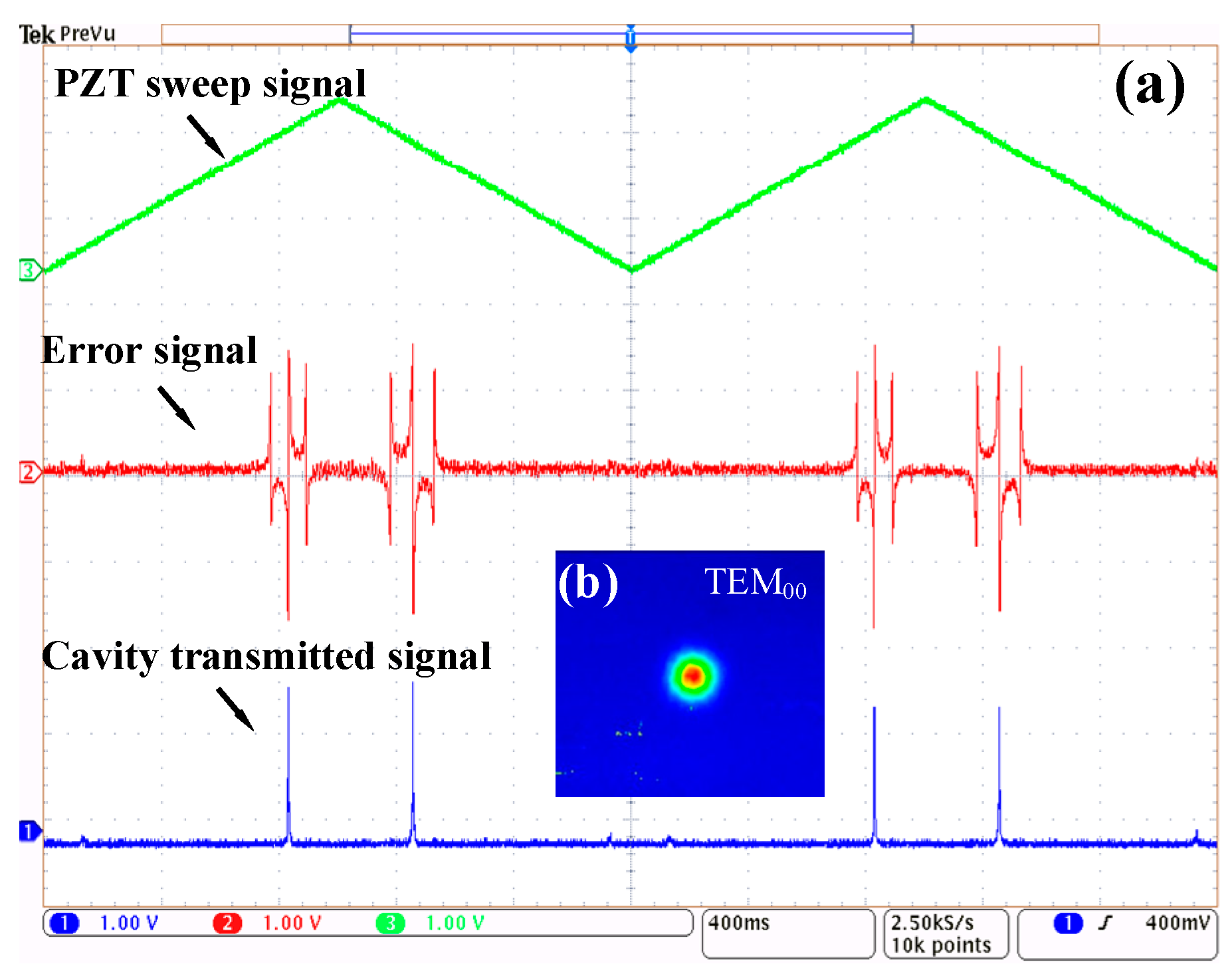
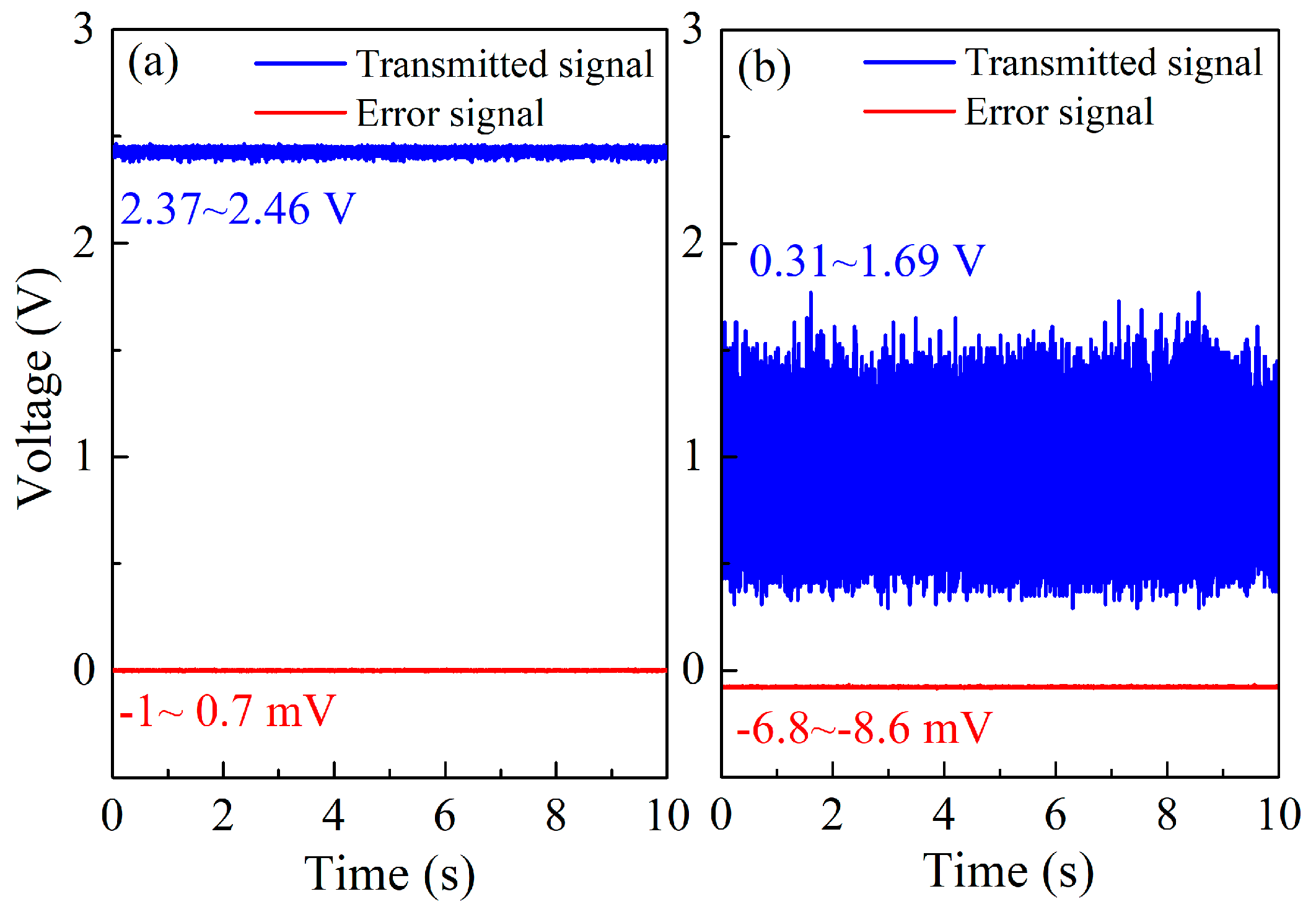
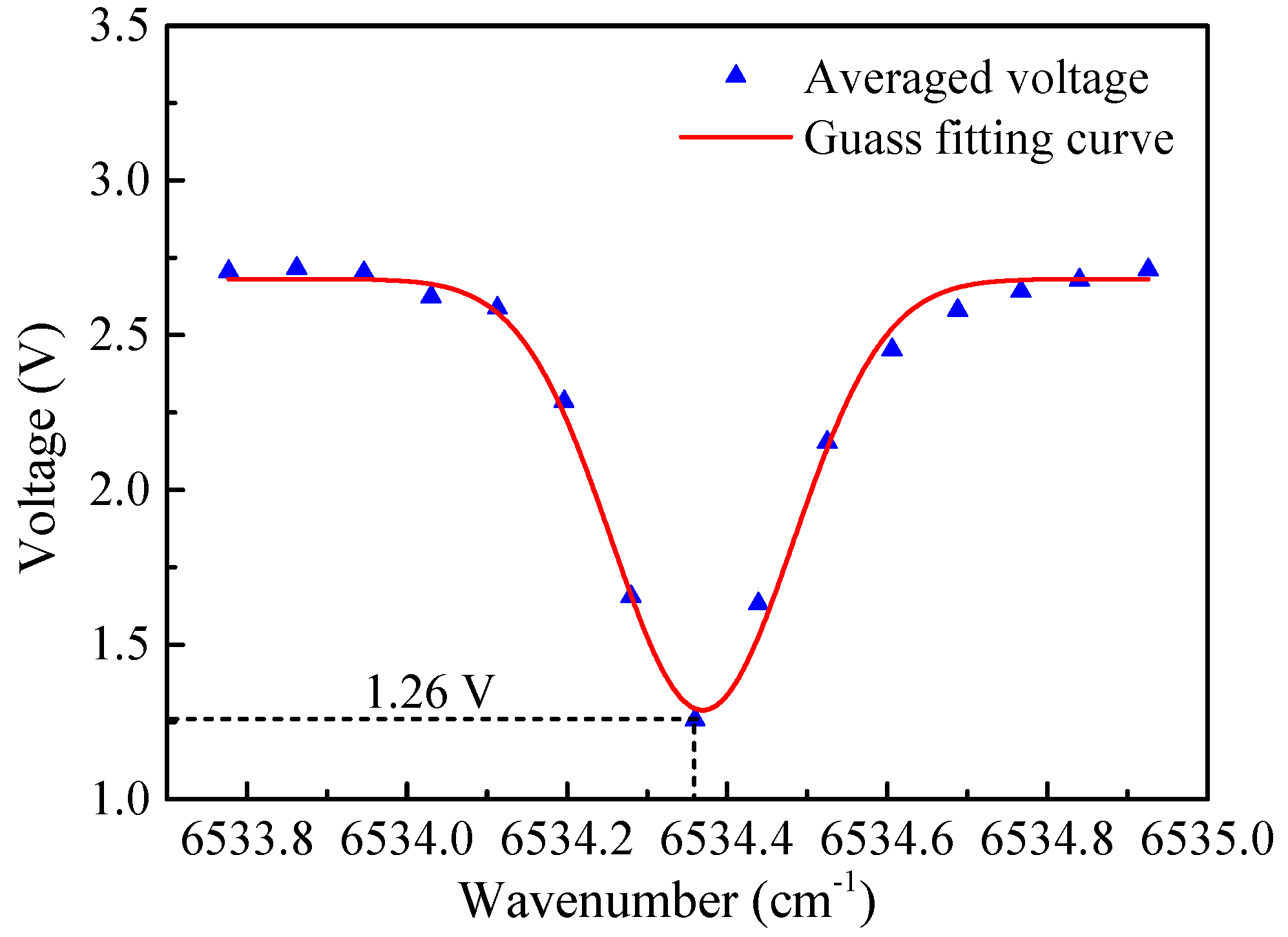
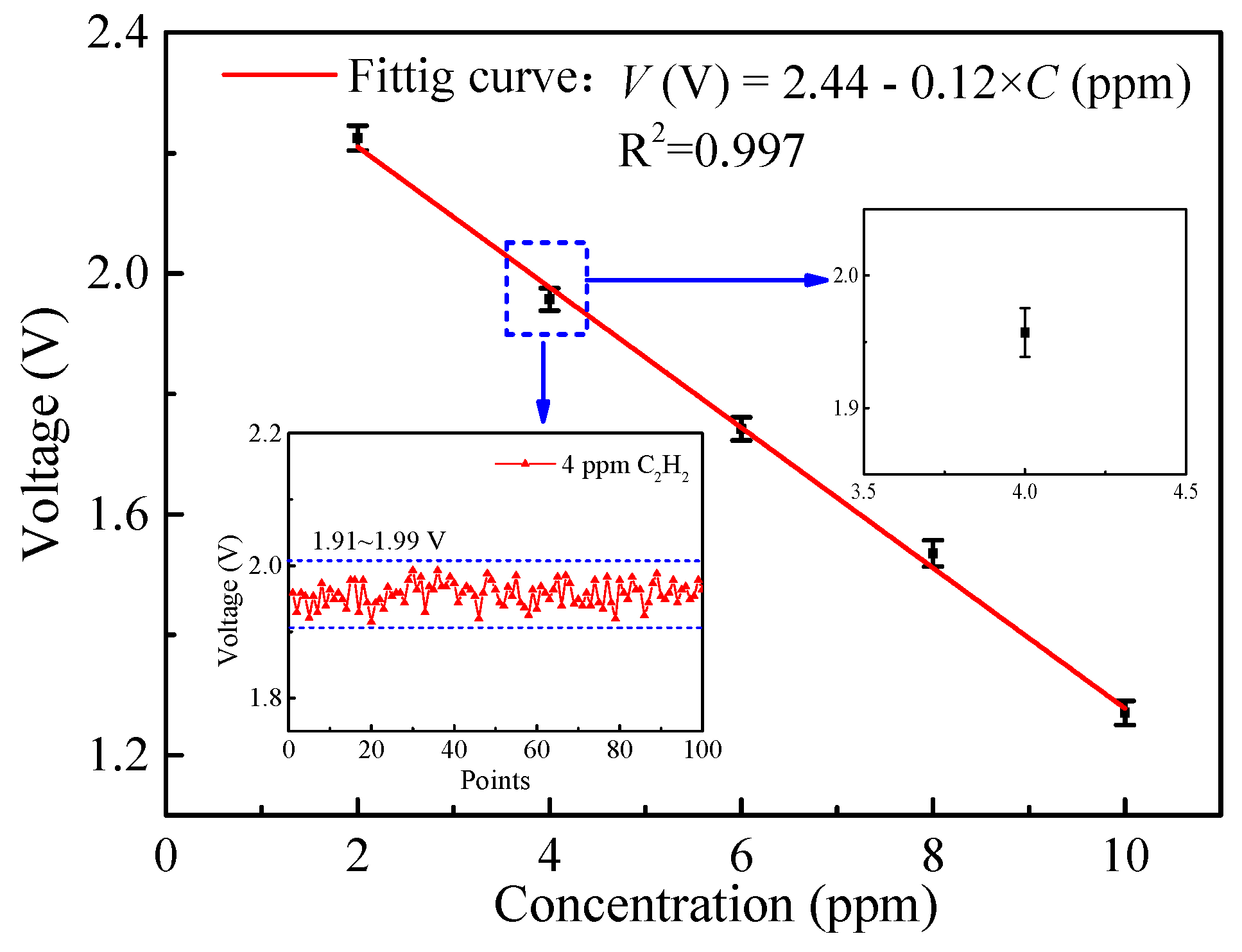
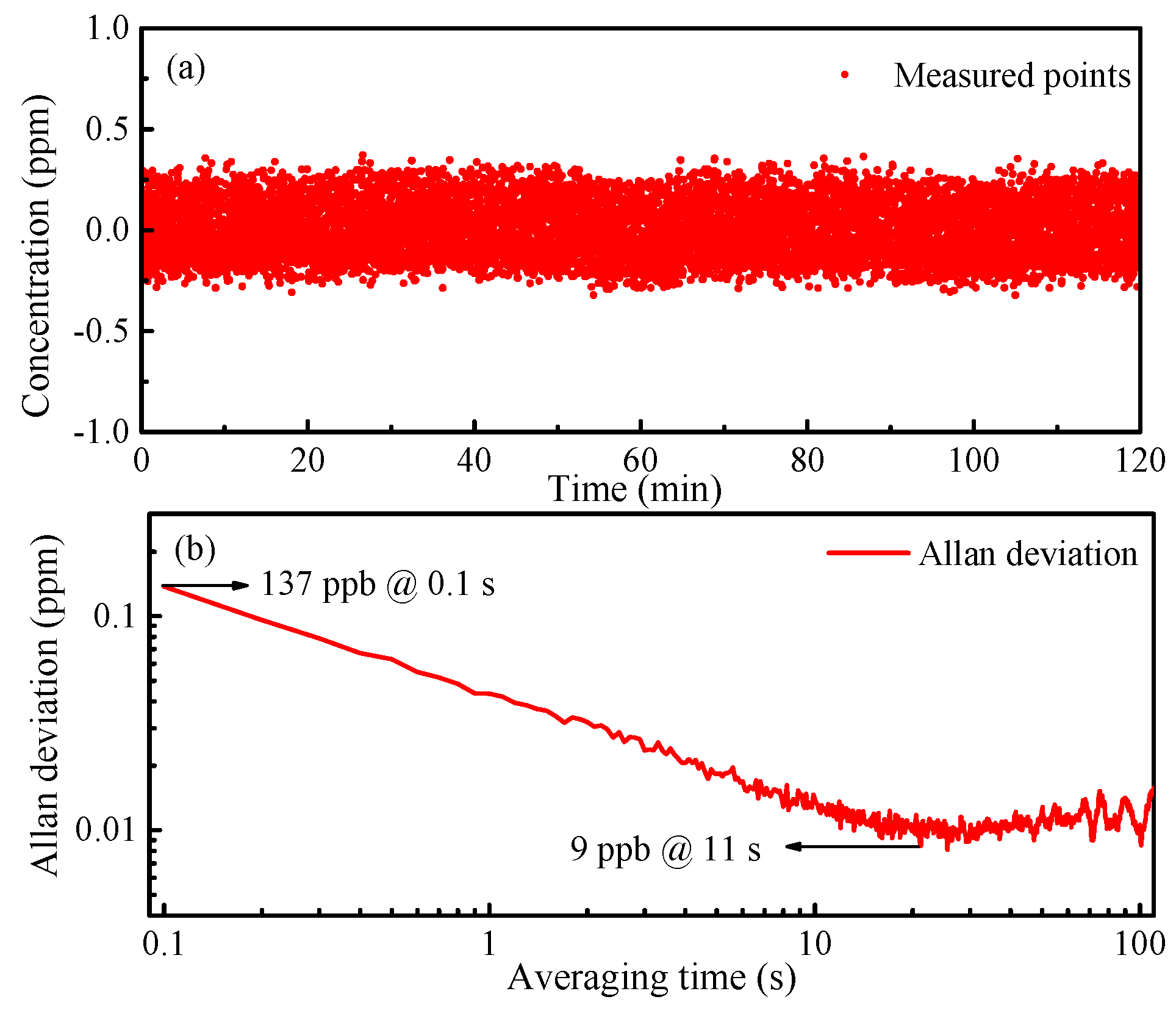
| Symbol | Value | |
|---|---|---|
| Cavity length | L | 15 cm |
| Reflectivity | R | 99.4% |
| FSR | fFSR | 1 GHz |
| Linewidth | Δvc | 1.92 MHz |
| Finesse | f | 520.8 |
| Equivalent Absorption length | Leff | 49.7 m |
| Refs. | Principal | Source Type | Optical Path | LoD |
|---|---|---|---|---|
| [2] | QEPAS | DFB (1.53 μm) | / | 2 ppm |
| [3] | TDLAS | DFB (1.53 μm) | 30 cm | 540 ppb |
| [25] | TDLAS | ICL (3.026 μm) | 20.4 cm | 1 ppb |
| [26] | TDLAS | DFB (1.53 μm) | 10.1 m | 0.49 ppm |
| [27] | OA-ICOS | DFB (1.53 μm) | 9.28 m | 85 ppb |
| This paper | CEAS | DFB (1.53 μm) | 49.7 m | 9 ppb |
© 2019 by the authors. Licensee MDPI, Basel, Switzerland. This article is an open access article distributed under the terms and conditions of the Creative Commons Attribution (CC BY) license (http://creativecommons.org/licenses/by/4.0/).
Share and Cite
He, Q.; Feng, Q.; Li, J. Long-Term Stable Online Acetylene Detection by a CEAS System with Suppression of Cavity Length Drift. Sensors 2019, 19, 508. https://doi.org/10.3390/s19030508
He Q, Feng Q, Li J. Long-Term Stable Online Acetylene Detection by a CEAS System with Suppression of Cavity Length Drift. Sensors. 2019; 19(3):508. https://doi.org/10.3390/s19030508
Chicago/Turabian StyleHe, Qixin, Qibo Feng, and Jiakun Li. 2019. "Long-Term Stable Online Acetylene Detection by a CEAS System with Suppression of Cavity Length Drift" Sensors 19, no. 3: 508. https://doi.org/10.3390/s19030508






